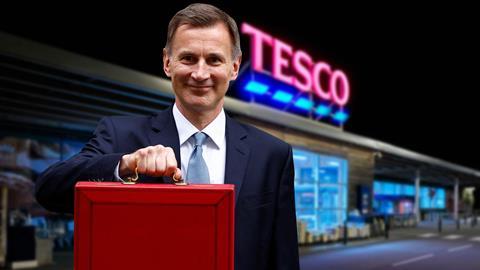David Cameron’s pet project was meant to boost opportunities for apprentices, but companies say most of the money is disappearing into the Treasury’s pockets. What’s going on?
Swindle. Scam. Disastrous. You name it, the Apprenticeship Levy has been called it. In fact, from the day it was first proposed by then prime minister David Cameron in August 2015, the scheme has attracted perhaps more industry ire than any other policy in recent history. That’s no small feat.
The levy aims to raise money to help boost Britain’s apprenticeship opportunities, yet businesses, trade bodies, and training providers alike have all complained that the scheme is overly bureaucratic, prioritising quantity over quality, and places an unfair, unworkable, and even exploitative tax on larger businesses.
In recent weeks, that criticism has ramped up a notch. In February, leading trade bodies including the British Retail Consortium and UKHospitality wrote to government and branded the policy “broken”.
They argued that billions of pounds paid into the pot had expired due to the “narrow way” in which the scheme could be used, and there was no clarity forthcoming as to where those surplus funds ended up.
A week later, M&S CEO Stuart Machin outlined how the levy’s “overly bureaucratic, restrictive” system had seen the grocer lose almost £8m in total since April 2021. And in March, Tesco CEO Ken Murphy added his voice to the fray, calling for a rethink to the “outdated rules” that prevent hundreds of millions of pounds being invested into meaningful community schemes, citing its own experience, whereby only 14% of the £100m it’s invested since 2017 has been accessed.

What Tesco CEO Ken Murphy says…
“We’re not able to offer as many opportunities as we’d like to, opportunities that are desperately needed, because of outdated rules around the Apprenticeship Levy. Intended to fund more apprenticeships, the levy has actually had the opposite effect by unfairly prioritising senior level apprenticeships over those at entry level. This means the levy is reducing apprenticeship opportunities for those who would benefit most.”
“Retailers want to invest more in training a higher skilled, more productive and better paid workforce,’ says BRC CEO Helen Dickinson. “They want to create more opportunities for people up and down the country. They want to contribute more to growth. But the broken apprenticeship system is a ball and chain around their efforts.”
The Apprenticeship Levy was intended to be a way to bolster the number of apprenticeship places available in the UK by placing a greater burden on large businesses to fund and provide places. The scheme requires those companies with a wage bill of £3m or more to pay 0.5% of their monthly payroll as a levy tax. This tax sits in a centralised pot from which, in theory, those same businesses can claim back a decent chunk of the funds when they take on new apprentices, incentivising them to do so.
In theory, at least, there’s plenty of support for the approach. UKHospitality, for example, welcomed the shift in focus when it happened and supports an employer-led approach to boosting skills, says Sandra Kelly, the trade body’s skills director. She even points to the “hundreds of thousands of successes” that have delivered “life-changing opportunities” for those who want an alternative to university.
The trouble is, say critics, the scheme doesn’t work as advertised and is even hampering access to further training.
A major supermarket, for instance, cannot simply claim funding back for any apprentice it takes on. Instead, it must jump through certain hoops: qualifying courses need to last at least one year; at least 20% of an apprentice’s time must be spent on the off-the-job training; and all programmes need to be supported by signed apprenticeship agreements and in-depth individual learning plans as laid out by the Education & Skills Funding Agency.
In sectors like grocery and hospitality, the scheme excludes short, tailored courses in high demand, and provides little to no flexibility to reflect the reality of working in these industries. It also fails to encompass a broad enough range of entry-level skills and programmes, critics add.
As a result, huge sums of cash appear to have gone missing. It emerged in the House of Lords last month that the Treasury has raised £13.9bn from the Apprenticeship Levy since it began in April 2017, and yet has only spent £11.2bn. That leaves a total of £2.7bn unaccounted for, including £600m last year alone, as Murphy pointed out.
The figures came in response to parliamentary questions tabled by Lord Dean Godson, director of Policy Exchange, and add to the sense of fury. But there are monthly reminders of the sums going down the drain, as unspent funds are removed from the accrued levy pot. At M&S, for example, Machin says the grocer is losing around £365k each month from its £5.4m annual contribution.

What former education secretary Justine Greening says…
“The introduction of the levy was a hugely positive step, which has enabled many apprenticeship opportunities nationwide, but five years on and with billions of levy going unspent by employers, there’s a risk that without serious reform the levy doesn’t level up Britain in the way we intended when we brought it in.”
Where is the money going exactly?
In theory, funds that can’t be used by larger business should be rediverted to fund apprenticeships at SMEs instead. A spokesman for the Department for Education insists this is the case. “Where there are underspends from levy-paying employers, these are re-allocated to fund demand for apprenticeships from smaller employers,” he tells The Grocer. “In the last financial year, we were encouraged to see employers utilised over 99% of the apprenticeship budget.”
But big businesses are sceptical. One senior figure tells The Grocer it was their understanding the funds went back to the Treasury, highlighting again the lack of transparency over how significant sums of cash were being rediverted. As Machin pointed out, unclaimed funds “could be spent on anything the Treasury fancies”.
The Apprenticeship Levy in numbers
2017
The year the levy came into force
0.5%
The proportion of total salaries paid into the fund by businesses
£3.2bn
The amount paid into the pot in the financial year ending April 2022
£750m
The amount raised but not spent in 2021/2022
55%
The average amount that retailers can currently access of funds they’ve paid in, according to the BRC
95%
The subsidies received by SMEs for apprenticeship training as a result of the levy, according to government
But it’s not that black and white, says the Chartered Management Institute. “An underspend is not in itself a bad thing,” says a spokeswoman. “Any money not spent by levy-paying employers is, by design, meant to be diverted to non levy-paying employers – mostly small businesses.
“The problem is that there is no public information about which small businesses are getting access or the impact it is having in their business.”
Amid concern from many that money is simply being absorbed into other skills and training priorities, others insist it isn’t fair to lay all blame with the levy itself for the current challenges. There are multiple reasons why the funds available for apprenticeships are currently not always being used as intended, points out Kelly at UKHospitality. And not all of them lie with government. These include “engagement, implementation, timing, resistance to change for the first few years – and not forgetting Covid,” she says.
What KFC UK general manager Meg Farren says…

“Every year we take on apprentices across the business, but the inflexibility of the system disincentivises businesses like ours that have specific training needs from investing. We want to see the Apprenticeship Levy redesigned to provide young people with the skills businesses today need. We need greater flexibility in the programme, so it’s easier for businesses to fully use the funds available to them.”
Capability strategies
Employers aren’t faultless here either, says David Brown, director of executive education at Imperial College Business School. “Many companies have not thought through a capability strategy [and] many others decline to give their employees the time to learn,” he says.
“If the Apprenticeship Levy surfaces the failure of many firms to invest in their people that is a good thing,” he adds. “Too often, capability development is not a strategic issue and is not on the finance directors’ radar. It should be.”
Regardless of who’s to blame, the discontent among employers is overwhelming, with 95% of retailers believing the current system needs to change, according to a 2022 BRC survey.
And, as well as a big bunch of disgruntled businesses, the impact of all this on apprenticeships has been the opposite of what Cameron intended when he first set out his plan eight years ago.
The number of new apprentices fell by 69% from 2015/16 to 2021/22, with intermediate or entry-level apprenticeships (those most likely to be available in industries such as grocery and hospitality) the worst affected, falling by a fifth (18.4%) between Q1 of 2022/2023 and a year earlier.

What Marks & Spencer CEO Stuart Machin says…
“The levy costs us £5.4m per year and we’re currently losing around £365k every single month in unspent funds that could be spent on anything the Treasury fancies. Since April 2021 we have lost almost £8m in total – which is frankly ludicrous. Just think what training we could have provided to colleagues across the UK with it. Put simply, the levy is a tax on opportunity and on growth, and is in desperate need of reform.”
Even when apprentices do sign up to schemes, in some organisations the drop-out rates are as high as 80%.
“People start with good intentions but the apprenticeship is so dull that they cannot find the motivation to continue it,” says Dominic Ashley-Timms, co-founder of management improvement consultancy Notion and co-creator of its management development programme Star Manager.
That’s in part due to an ongoing focus on knowledge-based learning rather than application, he says, as well as a competitive training market that has boomed since the introduction of the levy but which is constantly having to balance the provision of innovative courses with the fixed sum they can draw down from the fund.
This comes back to the criteria that apprenticeships must meet in order to be eligible for the levy, he adds. “[The levy] ties the hands of the employer to only being able to draw from the apprenticeships that exist,” he says.
“They’re not allowed to use that levy for other courses which might lead to a qualification, even though the apprenticeship market is not going to be able to respond as nimbly as they would want those skills to be developed.”
So, what needs to change? Well, there are plenty of amends that could improve how well the current system works and on which the BRC is calling for government to consider, says Tom Ironside, the consortium’s director of business and regulation.

What UKHospitality CEO Kate Nicholls says…
“Reform of the Apprenticeship Levy is urgently needed to offer greater flexibility to businesses, particularly in how funding is used. A much-needed overhaul of the system would enable businesses to go even further in their skills investment and deliver huge benefits for the wider labour market too, particularly in helping over-50s and the wider group of economically inactive back into work.”
These include allowing the fund to be used for pre-employment courses to help potential apprentices reach the required level to begin a full apprenticeship; minimise the costs associated with hiring an apprentice; put towards short courses that allow existing employees to upskill or transition to new roles; and allowing levy payers in devolved nations to directly access the funds they are being compelled to pay.
Currently, withdrawals in this form are restricted to England which is, says Ironside, “effectively another employment tax, penalising businesses for employing workers”.
Greater transparency and data on where the funds are currently ending up and their impact is also critical, says the Chartered Management Institute. This could include demographics of apprentices, the link between take-up and skills shortages, the impact on wider economic priorities and also company-level impact, such as pay, profitability and productivity.
“Better data is essential if we are to make more informed policy decisions about apprenticeship policy and how funding can be best targeted,” it adds.
The government, for its part, says it is open to change. A spokesman tells The Grocer: “We have continued to work with employers to make improvements to the levy, including creating flexible training models so apprenticeships are accessible for all sectors and improved the transfer system to make it easier for levy payers to transfer funds to other businesses.”
And, despite clear desire for change from many employers, there appears to be a broad consensus that the solution isn’t “throwing the baby out with the bathwater” when it comes to the levy either, says Sharon Walpole, partnerships director at jobs and apprenticeships network Careermap. “Apprentices are not a new thing and so people understand in principle what’s meant to be happening, It’s something they can grasp, both for those accessing the funds and the general public. To just scrap it would be disastrous for progression and training in this country.”




















No comments yet